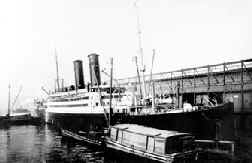| |
From Mourne to Montana
|
|
|
"Oh the sun is on the harbor, love.
And I wish I could remain
For I
know it will be a long, long time. Till I see you again"
|

|
| On
July 10, 1915, my Grandfather, Henry J. Doyle from Kilkeel boarded the SS
Tuscania in Glasgow for the nine day crossing to New York arriving at
Ellis Island on July 19, 1915. Henry J. travelled as a steerage passenger
and gave his final destination as Butte City, Montana. He was already in
possession of a ticket to Butte and of $30. The ship manifest for the SS
Tuscania, records Henry J. as being healthy, 5’10” tall with a fair
complexion and brown hair. He gave his occupation as "seaman". His place
of birth was recorded as Kilkeel, Ireland.
Mrs. Doyle, of
Newcastle St., Kilkeel was listed as his next-of-kin in Ireland. This was
Anne Doyle (nee Quinn), the widower of James Doyle who had died nine years
previously. This was Henry’s first trip to America and he stated that he
was going to see his friend John Rooney who was already living in Butte
City. |
|
|
|
 |
SS Tuscania
was the largest and finest ship of the Anchor
line, built in
1914 by Alexander Stephens & Sons, Ltd., at
Linthouse, Govan. The Tuscania was a ship of striking and imposing
appearance: length - 567 feet, breadth - 66 feet 6 inches, depth - 45
feet, gross tonage - 14,000 tons and a displacement of 20,000 tons.
The ship was able to accommodate 271 first
class, 246 second class, 1,900 third class passengers. The Liner was modern in every particular. The first class public rooms were on the promenade "A" deck, and consisted of a writing room, lounge room, smoking room, gymnasium, and veranda cafe. The special accommodations for second class passengers were on the shelter deck at the after end of the bridge. The third class passengers dining saloon and the galley, pantry, and scullery were in the main deck amidships. |
|
|
SOURCE: Steven Schwartz Vejv98b@prodigy.com |
|
His
friend John Rooney, (son of Patrick Rooney from Moneydarragh), had sailed
from Liverpool a month earlier on the SS Saint Paul arriving in New York on
June 13, 1915. John gave his final destination as the residence of his
cousin John McCarten at 67, East Copper St., Butte, Montana. John McCarten
himself had travelled to the United States three years earlier with his
friend Joseph Chambers (son of Hugh Chambers, from Glassdrummond) on the SS
Caledonia arriving in New York on April 1, 1912. |
| Researching the
Ellis Island
records reveals that Henry J. and his
friends had plenty of company from other young men from
Kilkeel and Annalong who had made the trip to the mines of Butte. Eight years previously, in
September 1907 Hugh and Andrew McConnell along with their cousin Robert
Burden headed to Butte to stay with Robert’s brother. Then on September 25,
1908, Joseph Maginn crossed the Atlantic and resided with his cousin Hugh
McConnell. Joseph Maginn, in turn, sent money home for his 21-year old
nephew Patrick Joseph Rogers to join him in 1914. Patrick joined his Uncle
at the boarding house at 67, East Copper St., Butte, Montana. A few weeks after Henry J’s arrival a cousin of his friend John Rooney
followed in his footsteps. James Rooney, (son of Patrick Rooney from
Ballymartin), arrived in New York aboard the SS Saint Paul on August 07,
1915. He too was heading for 67, East Copper Street and work in the Butte
mines. |
| |
|
|
| Back
in Ireland times were tough, with money,
employment
and transportation scarce.
Europe was in turmoil, with the war in
France in
full swing. In contrast to today's mechanised world the local postmen
normally spent a long day on a bicycle travelling many miles up hill and
down lanes
(referred to locally by the name of loanins) to deliver to the usually
small isolated farmhouses. The equivalent of today’s local telephone
service, part of his job was carrying the local gossip. It was a happy day
for him when he could reveal to his avid listeners that his bag contained
a ‘letter from America’.
Everyone knew, that this
meant cash and support in the months ahead for the lucky recipients.
However no one dreaming of the land ‘where the streets were paved with
gold’ and wondering how to get there,
will have known
just what had been the full cost of those dollars to the immigrant
carving out a new life away from their loved ones. |
|
